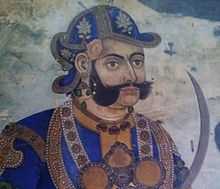Rana Jang Pande
| Rana Jang Pande | |
|---|---|
| Native name | रणजंग पाण्डे |
| Born |
1789 A.D Kathmandu |
| Died |
1843 A.D April 18 Kathmandu |
| Nationality | Nepali |
| Title | Mukhtiyar Kaji |
| Term | 1837 A.D-1840 A.D |
| Predecessor | Bhimsen Thapa |
| Successor | Ranganath Poudyal |
| Children | Badarjung,Tekjung,Samarjung,Shumsherjung |
| Parent(s) | Damodar Pande |
Rana Jang Pande was the 3rd Prime Minister of the government of Nepal and the second Prime Minister from the Pande family. He was one of the son of Mukhtiyar Kaji Damodar Pande.[1][2] He served as the Prime Minister for two terms, serving 1837 – 1837 (First Term) and 1839 – 1840 AD (Second Term). He became Powerfull after Bhimsen Thapa was arrested and was declared Mukhtiyar and Commander in Chief.
Rise in power
Ranjang Pande,was stationed as a captain in the army in Kathmandu. He was aware of the disunity between the Samrajya Laxmi and Bhimsen, and thus he had secretly expressed his loyalty to Samrajya Laxmi and had vowed to help her in bringing Bhimsen down for all the wrongs he had committed against his family.[3] Factions in the Nepalese court had also started to develop around the rivalry between the two queens, with the senior queen supporting the Pandes, while the junior queen supporting the Thapas.[4] About a month after Mathabar's return to Kathmandu, a child was born out of an adulterous relationship between him and his widowed sister-in-law. This news was spread all over the country by the Pandes, and the resulting public disgrace forced Mathabar to leave Kathmandu and reside in his ancestral home in Pipal Thok, Borlang, Gorkha.[3] To save face, Bhimsen gave Mathabar the governorship of Gorkha.[3]
Taking an advantage of Mathabar's absence in Kathmandu, the military battalions under his command were distributed to other courtiers during the annual muster at the beginning of 1837.[5] Nevertheless, Bhimsen managed to secure his and his family members' positions in the civil and military offices. An investigation was also started to check Bhimsen's expenditures in establishing various battalions.[5] Such events led the courtiers to feel that Bhimsen's Mukhtiyari would not last very long; thus Ranbir Singh, in the hopes of becoming the next Mukhtiyar, wrote a letter to the King asking him to be recalled to Kathmandu from Palpa. His wish was granted; and Bhimsen, pleased to see his brother after many years, made Ranbir Singh the acting Mukhtiyar and decided to go to his ancestral home in Borlang Gorkha for the sake of pilgrimage.[6] But in truth, Bhimsen had gone to Gorkha to placate his nephew and bring him back to Kathmandu.[6]
In Bhimsen's absence, Rajendra established a new battalion, Hanuman Dal, to be kept under his personal command. By February 1837, both Ranjang Pande and his brother, Ranadal Pande, had been promoted to the position of a kaji; and Ranjang was made a personal secretary to the King, while Ranadal was made the governor of Palpa.[7] Ranjang was also made the chief palace guard, the position formerly occupied by Ranbir Singh and then Bhimsen. Thus, this curtailed Bhimsen's access to the royal family.[7] On 14 June 1837, the King took over the command of all the battalions put in charge to various courtiers, and himself became the Commander-in-Chief.[8][9]
Decline from power

Mathabar Singh Thapa, who was exiled to India when Bhimsen Thapa was supposedly found to be guilty of murdering the King Rajendra's son who was 6 months old, was asked to return to Nepal by the queen. Mathabar Singh Thapa arrived in Kathmandu Valley in 1843 April 17 where a great welcome was organized for him.[10] After consolidating his position, he successfully led to the murder of all his political adversaries Karbir Pandey, Kulraj Pandey, Ranadal Pandey, Indrabir Thapa, Radabam Thapa, Kanak Singh Basnet, Gurulal Adhikari and many others, in several pretexts. The second queen of Rajendra, Queen Rajya Laxmi declared him Minister and Commander-In-Chief of the Nepalese army in 1843 December 25 believing he would help to usurp the power from Rajendra, her own husband, and make her own son, Ranendra as the king of Nepal.
Death
Rana jang Pandey was forced to see the murdered dead bodies of his brothers and nephews in April 18, 1843. Rana jang lying ill in his bed was not given death sentence. Rana jang was shocked to death after seeing the dead bodies of his brothers and nephews in 18 April 1843.
References
- Bhuwan Lal Joshi, Leo E. Rose, Democratic Innovations in Nepal: A Case Study of Political Acculturation.
- ↑ http://sanjaal.com/ganthan/tag/6th-prime-minister-of-nepal-fatte-jang-chautaria/
- ↑ http://www.weallnepali.com/about-nepal/prime-ministers-of-nepal
- ↑ 3.0 3.1 3.2 Acharya 2012, p. 155.
- ↑ Nepal 2007, p. 108.
- ↑ 5.0 5.1 Acharya 2012, p. 156.
- ↑ 6.0 6.1 Acharya 2012, p. 157.
- ↑ 7.0 7.1 Acharya 2012, p. 158.
- ↑ Acharya 2012, p. 215.
- ↑ Nepal 2007, p. 105.
- ↑ Sharma, Balchandra (2033 B.S.). Nepal ko Aitehasik Rooprekha. Varanasi: Krishna Kumari Devi. p. 295. Check date values in:
|date=(help)
